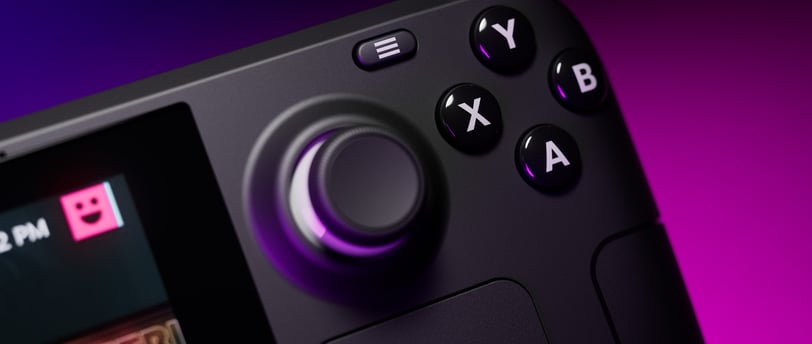Steam Deck Update: New Features and Performance Enhancements
Valve continues to refine the Steam Deck experience with exciting new features, and the latest update introduces significant improvements that users have been eagerly awaiting. From battery health optimizations to the rise of custom hardware like the Steam Brick, the Steam Deck community is thriving with innovation.
NEWS
2/6/20253 min read


Steam Deck Update: New Features and Performance Enhancements
Valve continues to refine the Steam Deck experience with exciting new features, and the latest update introduces significant improvements that users have been eagerly awaiting. From battery health optimizations to the rise of custom hardware like the Steam Brick, the Steam Deck community is thriving with innovation.
Introducing the Steam Brick: A Console-Like Steam Deck
A major development in the Steam Deck world is the emergence of the Steam Brick, a custom-built, stripped-down version of the Steam Deck. Created by modders using iFixit guides, the Steam Brick removes unnecessary components such as the screen and built-in controls, transforming the Steam Deck into a compact console-style device. This highlights the modular nature of Valve’s hardware and proves that Steam OS can run effectively on a device without a built-in screen or controller.
The Steam Brick showcases the flexibility of the Steam Deck’s design, allowing for creative adaptations that cater to different use cases. While there are limitations—such as the lack of volume buttons preventing easy BIOS access—workarounds exist, making this an interesting proof of concept. With growing interest in a potential Valve-built TV-based Steam Machine, the Steam Brick represents a glimpse into what could be an official future product.
Steam OS Expansion: Potential for Desktop PC Integration
Valve has been making strides toward expanding Steam OS beyond handhelds. With the upcoming Steam OS 3.7 update, many in the community are hoping for broader compatibility, including official support for desktop PCs. This move would solidify Steam OS as a viable alternative to Windows for gaming setups, allowing for increased flexibility and an expanded user base.
The growing list of supported devices, such as the ROG Ally and Legion Go, hints at Valve’s long-term plan to make Steam OS the go-to system for gaming across multiple platforms. However, true expansion will require widespread hardware compatibility beyond handheld devices, and the Steam Deck’s continued updates suggest Valve is heading in that direction.
New Battery Health Feature: Charging Limit to 80%
Battery longevity is a major concern for handheld gaming devices, and Valve is addressing this with a new battery health mode that limits charging to 80%. This feature is designed to extend the lifespan of the Steam Deck’s battery by preventing it from charging to full capacity, which can degrade battery health over time.
Similar to battery optimization features found in modern smartphones, this mode helps maintain optimal battery performance. By keeping the charge within the 20-80% range, users can prevent unnecessary wear, ensuring their Steam Deck remains functional for longer. While the feature is still in development, its eventual rollout will be a welcome addition for those looking to preserve their device’s battery health.
Steam Deck vs. Switch 2: Addressing the Recent Sales Rumors
A recent rumor suggested that the announcement of the Nintendo Switch 2 caused a significant drop in Steam Deck sales, but this turned out to be a temporary tracking error on Steam’s global sales rankings. While some assumed that anticipation for the new Switch model had overshadowed the Steam Deck, sales quickly rebounded, reaffirming its place among the best-selling gaming devices.
The reality is that the Steam Deck and Switch cater to different audiences. The Steam Deck is designed for players who want access to a full PC gaming library on the go, while the Switch is a closed ecosystem focused on Nintendo’s exclusive titles. Unlike traditional gaming consoles, the Steam Deck exists to expand the reach of the Steam platform, rather than compete directly with other hardware.
Optimized Performance: Best Settings for Red Dead Redemption 2
With the recent surge in Red Dead Redemption 2 players, optimizing the game for the Steam Deck has become a priority. Through testing, the best balance of performance and visuals was found by aligning settings with console-quality presets, providing a stable 30 FPS without significant frame dips.
Rather than pushing high settings, a mix of medium, low, and high settings ensures smooth gameplay. By tweaking certain graphical options, Steam Deck users can enjoy a fluid experience while maintaining reasonable battery life. Red Dead Redemption 2 remains a technical showcase, and the Steam Deck proves capable of running it smoothly with the right settings.
Final Thoughts
The latest Steam Deck developments, from the introduction of the Steam Brick to the long-awaited battery health mode, showcase Valve’s commitment to innovation and long-term support. With rumors of a future Steam Machine and the continued expansion of Steam OS, the Steam Deck’s influence extends far beyond handheld gaming.
As the device evolves, new features will continue to improve performance, battery longevity, and system compatibility, ensuring that Steam Deck users can enjoy a seamless gaming experience. Whether you're modding your device, optimizing game settings, or looking forward to future updates, there’s no shortage of excitement in the world of the Steam Deck.
What do you think about these updates? Are you excited about the new battery health feature and the potential for a Valve Steam Machine?
Discover the best games for Steam Deck today.
